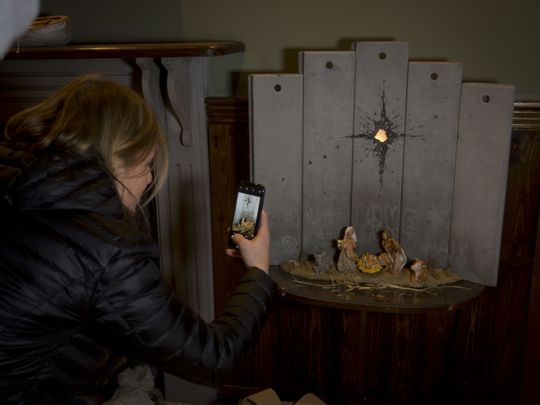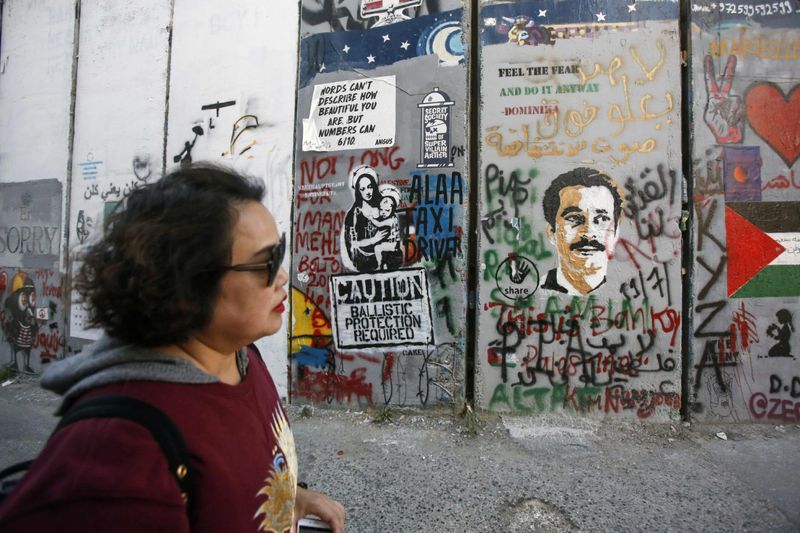
Christmas is upon us and those thousands of visitors from around the world celebrating it in Bethlehem, will find — all within walking distance of Manger Square, the site outside the Basilica of the Nativity, where Jesus was born — much to rejoice over: decorative street lights, street markets, street performances and street processions.
All well and good. But what about street art, especially the kind that is politically charged? This is where Banksy, the irreverent British master of the métier, whose identity remains a mystery but whose reputation as a subversive art icon made him Time magazine’s choice in 2010 for its list of the world’s most influential people, comes in. (For a picture of himself, Banksy provided one of himself with a paper bag over his head.) His art has appeared on walls in cities all the way from Vienna to San Francisco, Barcelona to Paris, and Gaza to Bethlehem.
And it is in Bethlehem last Saturday that Banksy unveiled a new artwork of his called, with little hidden irony, The Scar of Bethlehem, which depicts the birth of Jesus, with Joseph and Mary kneeling beside the crib in the manger. The background is a hideous concrete separation barrier pierced by what appears to be a bullet, creating the shape of a star. The artwork is displayed at the Walled Off Hotel in the small, occupied Palestinian city.

Banksy, who has a penchant for trenchant epigrams, opened the hotel, which directly overlooks the apartheid wall, in 2014 and called it just that (ignoring how the folks at the Waldorf luxury hotel chain may react) to draw attention to the plus-minus dichotomy that defines the relationship between Israelis and Palestinians as occupier-occupied. It bills itself — indeed, promotes itself — as having the ugliest view in the world, with nearly every window in everyone of its rooms opening up to that notorious 40-foot high wall. Every room, however, exhibits one of his works reflecting on diverse aspects of Palestinian life under occupation. In the Master Bedroom, for example, guests sleep on a bed showing a Palestinian activist and an Israeli soldier having a pillow fight.
Vicious war
The Walled Off Hotel, predictably, has attracted a new crop of pilgrims — roughly 140,000 since 2014 — who consider dropping in on the place as an integral part of their visit to Bethlehem, especially during the peak Christmas season.
Banksy’s street art appears everywhere in the West Bank, mostly on the apartheid wall, which snakes around the entirety of the West Bank. And two years ago he sneaked, obviously incognito, into Gaza, where he drew four murals there, one on a still-standing wall of a building destroyed during Israel’s 2014 devastatingly vicious war on the Strip, featuring the Greek deity Niobe cowering against the rubble. On another wall, he inscribed a warning that said: “If we wash our hands of the conflict between the powerful and the helpless, we side with the powerful — we don’t remain neutral”.
Banksy’s position on this morally pressing question is thus made clear.
One of the defining functions of traditional art, especially in art movements such as Dadaism and Surrealism, that emerged in the wake of the cataclysm of First World War, was to use visual images to bring about social change by generating thought, self-criticism and introspection. Fine, but traditional art and street art are different from each other. While a traditional artwork — say, Picasso’s 1937 Guernica, reportedly one of the most moving and powerful anti-war paintings in history — can be moved, with impressive ease, from the Museo Sofia in Madrid (its permanent home) for exhibition at the Louvre in Paris without suffering any diminution to its meaning, credibility and message, street art is anchored in, well, the street, that is, to its moment and place of immediacy — in the very environment it depicts.
Street art aims to impact street people — along, ideally, with others who empathise with them — not to produce art itself. In short, traditional art is what it is. To its sister version, however, street art is what it does, drawing on the intricate weave of the inner history of “street” life.
Some people become dedicated moralists because they want to make the world a responsible place, others become street artists because they want to make it a responsive one. If this sounds vaguely evocative of what Banksy may himself have said at one time or another, it is because the words we choose do him homage are his.
To celebrate Banksy’s work in a newspaper column like this is to find the man’s semantic fashions of expression echoing back at us, complete with their anarchic admixture of beauty and blemish.
— Fawaz Turki is a journalist, lecturer and author based in Washington. He is the author of The Disinherited: Journal of a Palestinian Exile.










